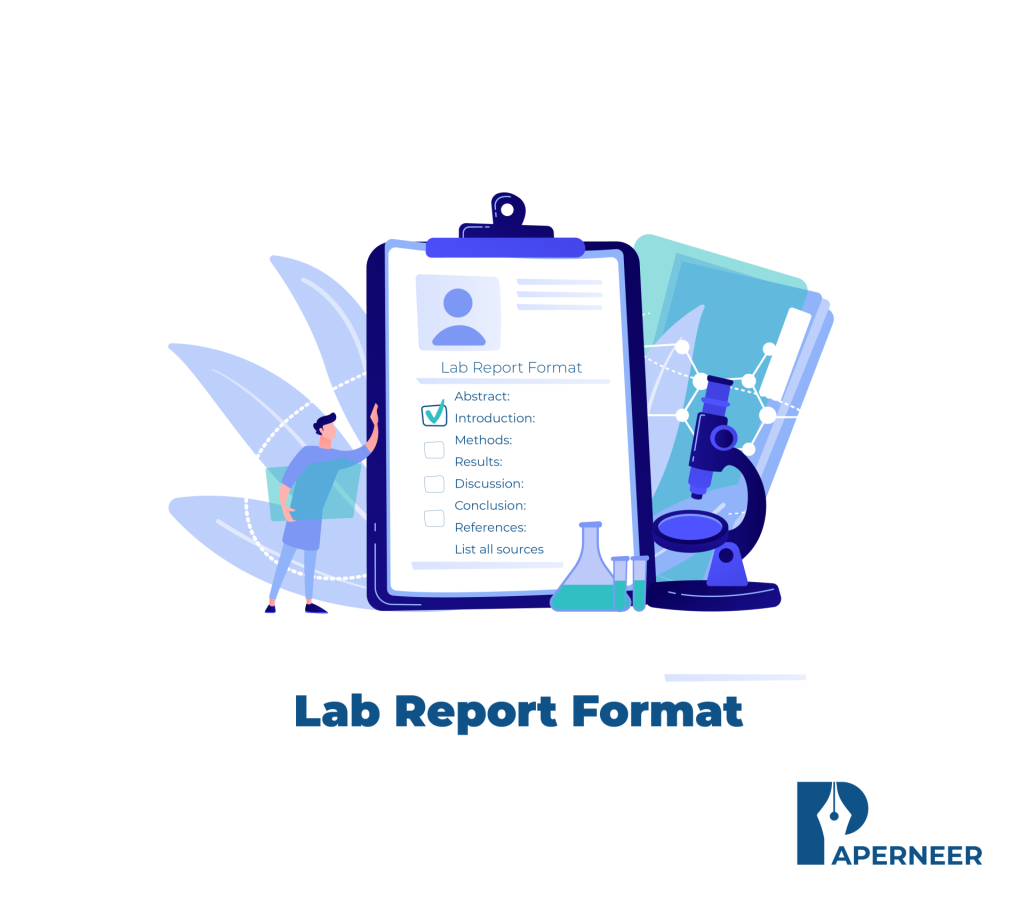Capstone Project – A Complete Guide A capstone project is sometimes the...
Read MoreLab Report Format - A Complete Guide

Writing a lab report is one of the most essential and complex tasks in science. Whether or not you’re a student or a knowledgeable scientist, understanding how to format your workplace report properly is vital to presenting your findings clearly and professionally. A well-organized report ensures that your analysis isn’t solely straightforward to follow; additionally, it goes into a tutorial setting. During this diary, we’ll dive into the essential parts of the lab report format, give a top-level view of economic writing, discuss the importance of employing a lab report format, supply examples to guide you and share valuable data formatting tips. By the top of this Guide, you’ll be equipped with everything you wish to craft a flawless lab report that adheres to the very best standards of academic writing.
In this blog brings you:
Lab Report Format
The Lab report Format isn’t just about presenting data—it’s a systematic method for transferring your analysis findings in an organized and professional way. A standard lab report generally includes many sections, every serving a definite purpose. Here’s a summary of the standard sections in a very lab report:
Title:
The title ought to be elliptic, nevertheless descriptive. It should replicate the experiment’s purpose and provide the reader with a clear understanding of the report’s focus.
Abstract:
The abstract may be a transient outline of the complete report. It ought to summarize the key elements of the experiment, together with the aim, methods, results, and conclusions. The abstract ought to be no over two hundred words, giving a fast summary of the complete report.
Introduction:
Within the introduction, you may justify the background of the experiment, the analysis drawback, and, therefore, the objectives. This section helps set the stage for the experiment and provides the context within which your analysis fits. It ought to additionally concisely define the hypothesis or the analysis question you’re attempting to deal with.
Materials and Methods:
This section ought to describe the materials, equipment, and procedures employed in the experiment. This section was written in the past and provides enough details so that other people may replicate the experiment.
Results:
The results section presents the information gathered throughout the experiment. This will embody text, tables, figures, and graphs. The results ought to be objective and free from interpretation.
Discussion:
This is often where you interpret the results. You ought to analyze whether or not the information supports the hypothesis, discuss potential errors or uncertainties, and justify the implications of your findings. Make sure to match your results with existing literature, if applicable.
Conclusion:
The conclusion summarizes the key findings of the report. It ought to address the analysis question and counsel potential enhancements or future analysis directions.
References:
Finally, embody an inventory of all the sources you cited in your report. This section is essential for providing credit to previous analyses and giving your readers resources to explore any.
By following this structured format, your laboratory report can give a logical, coherent, and skilled account of your analysis.
Lab Report Outline
Creating an overview before writing your lab report will save time and help you keep organized. It’s essential to structure the content of your report clearly, ensuring that you cover every section completely. Below could be an easy lab report definition that you just will follow:
- Title
- Abstract
- Introduction
- Research drawback
- Objective of the Study
- Hypothesis or research Question
Materials and methods
- Equipment and Materials Used
- Step-by-Step Procedure
Results
- Presentation of data (tables, graphs)
- Observations
Discussion
- Interpretation of Results
- Comparison with Hypothesis
- Possible Errors and Enhancements
Conclusion
- Summary of Findings
- Implications of Results
- References
Citation of All Relevant Literature
The definition is a roadmap to writing your report, making sure you don’t jump over any vital sections. This organization will also help your readers follow your experiment’s progression from hypothesis to conclusion.
Lab Report Template
A lab report template may be a helpful tool that simplifies the writing method. It provides you with a framework to follow, ensuring you don’t forget any essential components. Here’s a basic lab report format model you can use for your next experiment:
Title:
[Insert Title Here]
Abstract:
[Summarize the experiment’s purpose, methods, results, and conclusions in an exceedingly few brief sentences.]
Introduction:
[Explain the background, analysis question, hypothesis, and objectives of the study.]
Materials and Methods:
[Detail the instrumentation, materials, and ways to experiment.]
Results:
[Present the info collected throughout the experiment. Embody graphs, tables, or figures as an instance of key findings.]
Discussion:
[Analyze the results, discussing whether or not they support your hypothesis, attainable errors, and suggestions for improvement.]
Conclusion:
[Summarize the findings and recommend potential future analysis directions.]
References:
[List all references, following the desired citation vogue.]
Using a model like this ensures consistency in info and structure, which is essential when presenting technical or scientific data. Adapt the sections to be consistent with your experiment’s wants and the specific needs of your assignment or establishment.
Lab Report Examples
Looking at lab report examples will offer helpful insights into a way to structure your report. Examining examples helps you visualize a way to present information and write up numerous sections of the report. Here’s AN example of however information may be bestowed within the results section:
- Title: Effect of Temperature on Catalyst Activity
- Abstract: This experiment aimed to research the impact of varied temperatures on catalyst activity. The results showed that catalyst activity increased with temperatures up to 37°C and small at higher temperatures.
- Introduction: Enzymes play an essential role in biological reactions. This experiment tests the impact of temperature on the activity of the catalyst enzyme, hypothesizing that catalyst activity can increase with temperature up to AN optimum purpose.
Materials and Methods:
- Materials: enzyme catalyst, starch answer, water bath, measuring device
- Methods: The enzyme was superimposed to starch answer at totally different temperatures, and therefore, the reaction was measured over a half-hour.
Results:
A table showing catalyst activity at numerous temperatures (0°C, 10°C, 20°C, 30°C, 40°C, 50°C) reveals that catalyst activity peaked at 37°C, after that it sharply declined.
Discussion:
The results ensure the hypothesis that catalyst activity will increase with temperature to an optimum level, on the far side that the catalyst is denaturized. The decrease in activity on top of 37°C supports this.
By viewing workplace report examples, you’ll gain an improved understanding of how to present information clearly and analyze results effectively.
Lab Report Formatting Tips
Proper formatting is essential for clarity and expertise. Here are some lab report info tips to stay in mind:
- Font and Spacing: Use a decipherable font like Times New Roman in 12-point size, and set the document to typewriting. This improves readability and ensures the report adheres to tutorial standards.
- Headings and Subheadings: Use clear and consistent headings to demarcate every section of your report. This helps the reader simply navigate through the report.
- Tables and Figures: Once information is presented, tables or figures are invariably embodied to make it easier for the reader to interpret the results. Label every table and figure clearly with descriptive captions.
- Active Voice: whereas scientific writing usually involves passive Voice, attempt to use Voice as much as possible. It makes your writing a lot of partaking and direct, helping the reader to connect with the data you’re presenting.
- Be Concise: Avoid surplus detail in your writing. Every section ought to be terse and, nonetheless, informative—Specialise in presenting solely the essential data while not overwhelming the reader.
- Proofread: Before submitting your workplace report, ensure for orthography and grammatical errors. Make sure the document flows logically and every section is complete.
Conclusion
Understanding the proper lab report format is crucial for any student or researcher. By adhering to a transparent structure, following a helpful science lab report definition, and utilizing a lab report example, you can simply write and present your analysis findings. To boot, watching lab report examples provides insights into the way to structure your results and analysis effectively. Lastly, applying lab report data formatting tips can guarantee your report looks professional and adheres to academic standards. With these tools at your disposal, writing a comprehensive and practical lab report is a much easier and more efficient task.
Say goodbye to Mistakes in Term Papers
Avoid Errors in Term Papers Writing a theme may be a vital tutorial task that needs careful designing and...
Read MoreUnraveling the Stories: Autobiography vs Biography
Autobiography vs Biography Understanding the excellence between autobiography and biography is crucial for...
Read More




